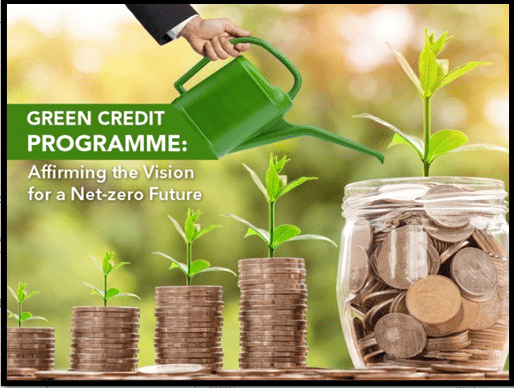“ANALYZING INDIA’S GREEN CREDIT PROGRAMME”
Syllabus:
- GS-3- Environment and ecology , Regeneration of wasteland and related policies
Focus :
- The Environment Ministry introduced the Green Credit Programme in October 2023.
- It is a market-based mechanism allowing individuals and companies to claim incentives, termed ‘green credits,’ for contributions to environmental and ecological restoration.
Source- GoI
Understanding the Green Credit Programme
- Some experts view the programme as an incentive mechanism to promote green and sustainable actions by involving various stakeholders.
- Some highlight the importance of ground-level awareness and expertise in implementing the programme effectively.
About Green credit Program:
Carbon Credit :
|
Scope and Sectors Covered
- Green Credit Programme encompasses six or seven sectors, including forest and waste management.
- Implementation quality and awareness of ground-level challenges are critical for the programme’s success.
Incentivizing Restoration of Degraded Forest Land
- The programme aims to incentivize the restoration of degraded forest land, addressing natural and man-made factors contributing to forest degradation.
- Concerns arise regarding the potential negative consequences of monoculture plantations and unsuitable vegetation promotion.
Challenges in Forest Regeneration
- The focus on planting trees for earning credits overlooks the complexity of forest ecosystems and biodiversity conservation.
- Regenerating forests requires protection from disturbances rather than major interventions, emphasizing the need for a nuanced approach.
Measurement and Fungibility
- The challenge of measuring and equating different environmental outcomes, such as biodiversity conservation and carbon sequestration, poses a significant hurdle.
- Fungibility is lacking in the Green Credit Programme, complicating the trading system and evaluation of credits.
Impact on Mandatory Compliances and Environmental Laws
- The use of green credits in mandatory compliances, such as forest clearances, raises concerns about bypassing established processes and compromising environmental laws.
- Potential clashes with existing environmental legislation, particularly the Forest Conservation Act, underscore the need for a nuanced and principled approach.
Balancing Economic Growth and Environmental Protection
- The Green Credit Programme raises questions about balancing economic growth and environmental protection.
- Simplifying processes for industry ease of doing business should not compromise environmental integrity or bypass regulatory safeguards.
Strengthening Environmental Governance
- Addressing the lack of clarity and definitions in the programme, particularly regarding forests and degraded land, is crucial.
- Strengthening environmental laws and ensuring adherence to principles of environmental governance are essential for effective implementation.
Conclusion: Towards Sustainable Environmental Management
- The Green Credit Programme presents opportunities for incentivizing environmental restoration and sustainability.
- However, challenges such as measurement complexities, fungibility issues, and potential conflicts with existing laws necessitate careful consideration and refinement.
Source:The Hindu
Mains Practice Question :
GS-3
Discuss the objectives, scope, and challenges of India’s Green Credit Programme. Evaluate its potential impact on environmental restoration and regulatory compliance, with a focus on the balance between economic growth and environmental protection.” (250 words)




